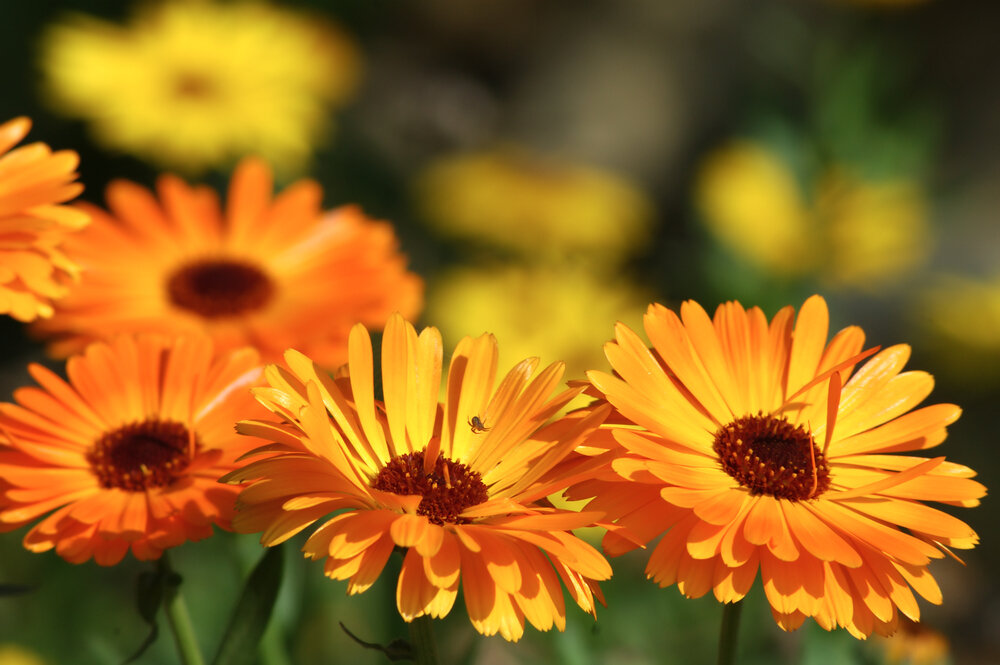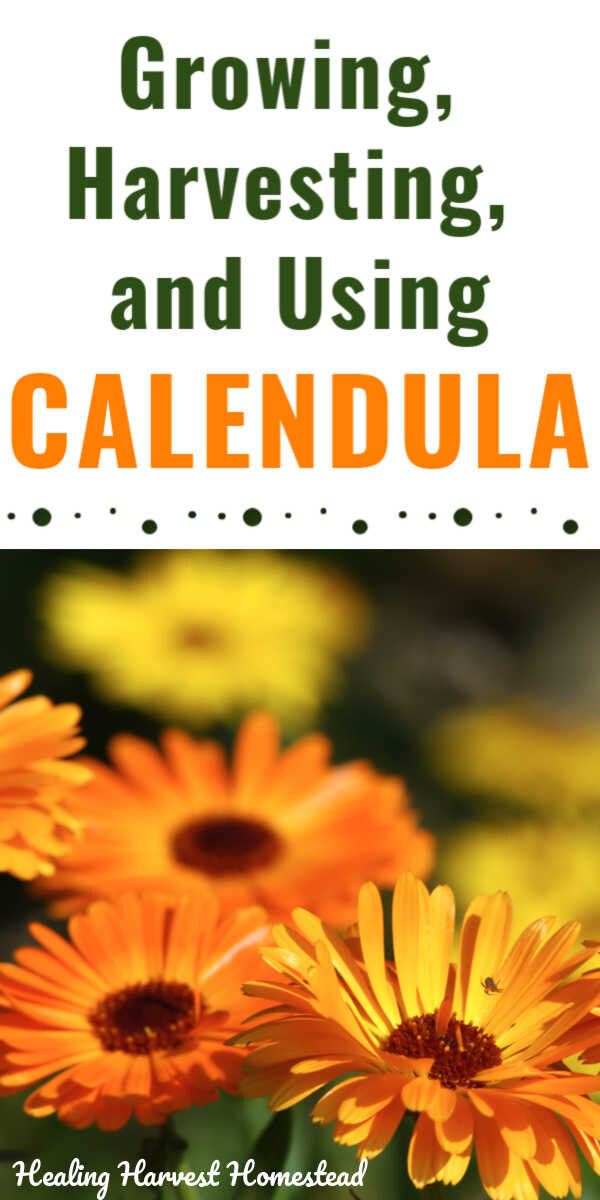Things to Do with Calendula Flowers
This article concerns growing, harvesting, drying, and storing calendula (Calendula officinalis) flowers. Incredibly useful for both food and medicine, calendula flowers are also beautiful additions to your healing garden. Here’s a brief guide to this beautiful flower you can grow in pots (container gardens) or the ground.
My hope is that this short excerpt from my masterclass, Everything Calendula found in the Confident Herbal Tribe Community, will motivate and inspire you to grow this helpful and beautiful flower yourself!
Calendula, sometimes known as the “sunshine herb,” is a plant that every home apothecary should include! Its sunny blooms brighten the summer landscape all the way into fall, or first frost, and in some places, they bloom all year round!
Calendula is an exceptional ornamental plant for your garden and has a long history of medicinal uses, dating back thousands of years.
It’s also excellent as a culinary herb, adding color and a bit of taste. Even hundreds of years ago, kitchen wives added it to huge pots of stew and soups, hence its nickname “pot marigold.” The nickname may have also come from the fact that calendula grows very well in pots, too. I’ve heard both origins for this nickname.
Go ahead and try the flowers or petals in your salads for some fun color!
Calendula is NOT the marigold many of us think of when we think “marigold” here in America. Marigolds are part of the Tagetes genus, and Calendula is a genus all on its own....it is a very different flower, with very different properties.
This is an important distinction, as Tagetes (common marigold) can be toxic, depending on the species, and calendula has no toxicity whatsoever. This is where it’s so important to know and understand the Latin binomial (scientific name) for any plant you use for food or medicine.
Calendula has many uses, ranging from medicinally topical and internal, for popular body care products, and is also used in some cultures for spiritual and religious ceremonies and cooking. It’s absolutely a worthwhile plant to consider growing in your garden!
FTC Disclosure: There are affiliate links here and there in this article. If you click through and make any kind of purchase, I may earn a small commission at no extra cost to you.
Ready to learn herbalism and aromatherapy and other natural and traditional skills? Check out our growing school! We have a course or two for you!
Growing Calendula
Native to Southern Europe, calendula has naturalized in temperate and hot climates worldwide. It grows about 18 inches tall and has lovely orange and/or yellow flowers about two to three inches in diameter.
You’ll notice resin all over the plant, which is highly valued for medicinal purposes. Most of it is found in the flower heads, which are prized for their beauty, nutrition, ceremonial uses, and medicinal uses.
Calendula is a self-seeding annual plant, and although you may find it in the wild, you will often find it in people’s gardens. You can cultivate it very easily and decide exactly where you want it to grow, or do as I do and just toss the seeds out there with abandon.
If you’re considering companion planting, or choosing plants that are helpful in your garden, calendula is a winner. It’s one of those plants that simply plays well with all other plants. There’s nothing you can plant calendula with that disagrees with it and vice versa.
I love calendula, and I welcome it everywhere. It won’t take over an area and is very easy to control. It also plays well with other plants and doesn’t choke them out.
If you live in a cold area, you can start calendula indoors as transplants later. If you live in a very hot climate, calendula does best in the cooler spring and fall and, depending on your zone, perhaps even the winter.
You can “almost” neglect calendula, as it doesn’t need much attention. With decent soil, good water, and your calendula, you will be happy! Keeping the plants dead-headed will help more flowers emerge. This is great news if you plan to harvest your calendula to use dried and store it throughout the winter months for teas, etc. The more you harvest, the more flowers you’ll get!
The seeds look a bit strange. They are curved in a half circle with a somewhat reptilian or scaly looking top. You’re not looking for cute little seeds from this flower! They are easy to save and keep for the next year, if you’re not letting them self-seed.
Click here to get your FREE Herbal Remedy Guide and Cheat Sheet on 10 common and easy to find herbs. It’s perfect for your home apothecary or kitchen!
Varieties of Calendula:
There are fifteen to twenty different species of Calendula, and the wild type is called Calendula arvensis, (of the field). These are the kind you are likely to find the world over growing wild in the fields. (Millard) However, since they are so easy to grow and have naturalized all over the world, why not just grow your own?
The types most used for medicinal applications is Calendula officinalis; and within this species are several varieties that are effective medicinally as well.
These include: Alpha, with very high resin content; Indian Prince, which is a lovely two-tone flower; and Resina, having the highest content of resin. (Millard) I have personally grown the resina variety as well as officinalis, and I really love both of them for their strong colors and medicinal properties.
Harvesting, Drying, and Storing Calendula
As with most herbs, you’ll need to know a few things in order to successfully dry and store calendula for longer term use.
Harvesting Calendula:
Harvest calendula in the morning, after the dew has evaporated.
The flowers open each morning with the sun, and will close in the late afternoon or early evening, also with the sun. You definitely want to pick them before they close up. Harvest as much as you like, because the more you do, the more flowers you’ll get!
I just pluck the flower head off the stem, and it comes off quite easily. Alternatively, you could use scissors or pruners.
Harvesting calendula is a perfect job for a young helper, if you have one. I’ve had my grand daughter as well as neighborhood girls love to take a basket out and pick to their heart’s content. When they get to help in preparing lotions or other preparations with the flowers, they are learning young herbalist skills!
Get your FREE Herbal Remedy Guide and Cheat Sheet! It’s so helpful for your home medicine chest or kitchen.
Drying and Storing Calendula:
Drying calendula is very easy, although you do need to make sure the flower heads are completely dry. You can lay them out on a towel in a n a warm, dry place with air flow. They will dry within a few to several days, depending on your humidity.
If you are in a very humid area, you’ll want to use a dehydrator set on the “herb” setting. This will dry the flowers very quickly and reduce the chance of mold forming on the moist heads.
I like to keep the whole head and use it all because most of the resin is found in the center of the flower.
The thing about using them for edible purposes that’s important to know is that the center is very bitter. If you don’t want extra bitters (very good for your digestion) in your foods, consider plucking off the petals only. They have a rather sweet flavor.
The petals are easiest to pluck off the head once the flower is completely dried…Just a tip.
Store the petals or the whole heads (or both) in air-tight glass jars in a cool, dark room or cupboard. The darkness of the room or cupboard is vital to a longer shelf life for the dried herb because unfortunately, sunlight oxidizes the flowers, causing the color to bleach out quickly.
Watch how I make this homemade Belly Balm for Stretch Marks and Scars using calendula infused oil! This is the BEST balm for itchy, pregnant skin, too. My daughter-in-law loved it and swears it helped her tremendously!
Final Thoughts About Calendula
There’s really a LOT more to learn about calendula in terms of its very broad medicinal value and uses. It’s one of those herbs that is supportive of a wide range of health complaints and is exceptional for supporting wellness over the long term.
If you’re trying to improve your gut health or dealing with stomach pains….try calendula. If you would like an absolutely incredible skin supporting herb that will help with aging skin as well as help heal scars and tissues more quickly, try calendula! If you start reading ingredient labels, especially for skincare products, it’s likely you’ll start to see it everywhere!
This is just a tiny bit to know about calendula. One way to learn about an herb in depth, from seed to plant; all. it’s uses and benefits; and all the ways to prepare and use a specific herb in great detail, is to study it in depth in a community. That’s where the Confident Herbalist Tribe provides you an affordable and excellent way to learn herbalism!
You may want to join our Confident Herbal Tribe community, where I teach my students about one herb a month deeply and thoroughly, along with recipes, remedies, a complete eBook and materia medica….and live Q&A sessions each week from me where you can ask ALL and any questions you like. In fact, the live weekly lessons are what will help you quickly grow into a confident family herbalist!
You can learn more here at The Healing Harvest Homestead School of Herbalism and Traditional Skills.
I can’t think of any better use of your time than honing your self-sufficiency skills and empowering yourself by learning to use plant medicine that you can grow or forage yourself!
You might also be interested in these other articles featuring calendula:
Calendula: Benefits & Uses, Plus Herbal Preparations
Calendula Rose Lotion (This is REAL lotion, not a greasy butter and such a nice recipe)
Calendula Tangerine Lotion Bars
Calendula Tangerine and Oatmeal Handmade Soap—-super moisturizing
Belly Balm for Stretch Marks and Scars
And you can see a video of this Belly Balm being made here, on YouTube.
Learn to infuse calendula in oil for making salves and balms here.
I hope you enjoyed learning how to grow, harvest, dry, and store this amazing herb! It grows freely in so many places, and I know you’ll love it as much as I do once you get it into your medicinal healing garden, or even your vegetable garden.
Hugs, Health, and Self-Reliance,
Heidi
P.S. Be sure to sign up for the newsletter and never miss a thing! You’ll get immediate access to the Resource Library, which is filled with downloadable and printable resources for your self-reliant and herbal lifestyle.
Just complete the form below!
If you’re wanting to know some of my favorite resources every herbalist should have on their bookshelf, here’s a quick list:
Rosemary Gladstar’s Medicinal Herbs: A Beginner’s Guide (perfect for beginners and experienced herbalists alike)
Richo Cech’s Making Plant Medicine, which is a quick and easy guide to making herbal preparations for specific plants using a standardized version.
For growing medicinal plants: The Organic Medicinal Herb Farmer
and Body Into Balance by Maria Noel Groves
There are a TON more I could mention, but these all rate high on my list of must-haves.
Of all the medicinal herbs you could choose to grow in your healing or culinary garden, calendula is a winner. It’s easy to grow, harvest, and use dried too. Here’s a complete guide to growing, harvesting, and using calendula in your yard and garden. #calendula #flower #growing #harvesting #flowerbenefits #uses #tea #healingharvesthomestead







